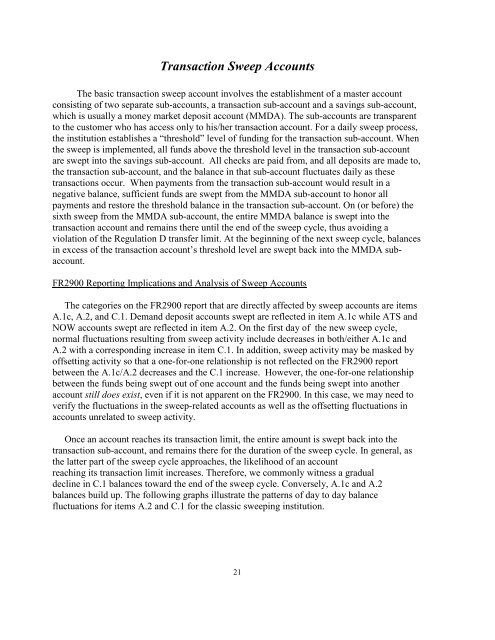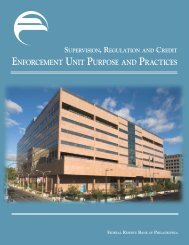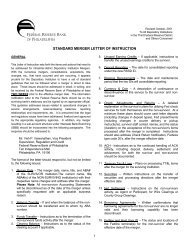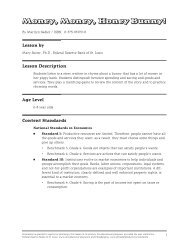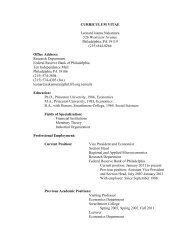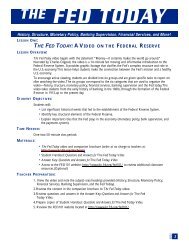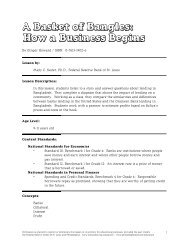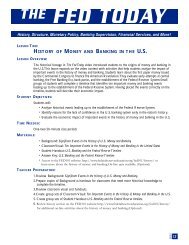The Facts Behind Your Figures - Federal Reserve Bank of ...
The Facts Behind Your Figures - Federal Reserve Bank of ...
The Facts Behind Your Figures - Federal Reserve Bank of ...
You also want an ePaper? Increase the reach of your titles
YUMPU automatically turns print PDFs into web optimized ePapers that Google loves.
Transaction Sweep Accounts<br />
<strong>The</strong> basic transaction sweep account involves the establishment <strong>of</strong> a master account<br />
consisting <strong>of</strong> two separate sub-accounts, a transaction sub-account and a savings sub-account,<br />
which is usually a money market deposit account (MMDA). <strong>The</strong> sub-accounts are transparent<br />
to the customer who has access only to his/her transaction account. For a daily sweep process,<br />
the institution establishes a “threshold” level <strong>of</strong> funding for the transaction sub-account. When<br />
the sweep is implemented, all funds above the threshold level in the transaction sub-account<br />
are swept into the savings sub-account. All checks are paid from, and all deposits are made to,<br />
the transaction sub-account, and the balance in that sub-account fluctuates daily as these<br />
transactions occur. When payments from the transaction sub-account would result in a<br />
negative balance, sufficient funds are swept from the MMDA sub-account to honor all<br />
payments and restore the threshold balance in the transaction sub-account. On (or before) the<br />
sixth sweep from the MMDA sub-account, the entire MMDA balance is swept into the<br />
transaction account and remains there until the end <strong>of</strong> the sweep cycle, thus avoiding a<br />
violation <strong>of</strong> the Regulation D transfer limit. At the beginning <strong>of</strong> the next sweep cycle, balances<br />
in excess <strong>of</strong> the transaction account’s threshold level are swept back into the MMDA subaccount.<br />
FR2900 Reporting Implications and Analysis <strong>of</strong> Sweep Accounts<br />
<strong>The</strong> categories on the FR2900 report that are directly affected by sweep accounts are items<br />
A.1c, A.2, and C.1. Demand deposit accounts swept are reflected in item A.1c while ATS and<br />
NOW accounts swept are reflected in item A.2. On the first day <strong>of</strong> the new sweep cycle,<br />
normal fluctuations resulting from sweep activity include decreases in both/either A.1c and<br />
A.2 with a corresponding increase in item C.1. In addition, sweep activity may be masked by<br />
<strong>of</strong>fsetting activity so that a one-for-one relationship is not reflected on the FR2900 report<br />
between the A.1c/A.2 decreases and the C.1 increase. However, the one-for-one relationship<br />
between the funds being swept out <strong>of</strong> one account and the funds being swept into another<br />
account still does exist, even if it is not apparent on the FR2900. In this case, we may need to<br />
verify the fluctuations in the sweep-related accounts as well as the <strong>of</strong>fsetting fluctuations in<br />
accounts unrelated to sweep activity.<br />
Once an account reaches its transaction limit, the entire amount is swept back into the<br />
transaction sub-account, and remains there for the duration <strong>of</strong> the sweep cycle. In general, as<br />
the latter part <strong>of</strong> the sweep cycle approaches, the likelihood <strong>of</strong> an account<br />
reaching its transaction limit increases. <strong>The</strong>refore, we commonly witness a gradual<br />
decline in C.1 balances toward the end <strong>of</strong> the sweep cycle. Conversely, A.1c and A.2<br />
balances build up. <strong>The</strong> following graphs illustrate the patterns <strong>of</strong> day to day balance<br />
fluctuations for items A.2 and C.1 for the classic sweeping institution.<br />
21


